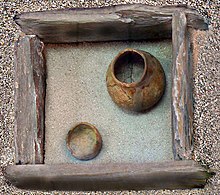Cist


A cist (/ˈsɪst/ or /ˈkɪst/; also kist /ˈkɪst/;[1][2] from Greek: κίστη, Middle Welsh Kist or Germanic Kiste) is a small stone-built coffin-like box or ossuary used to hold the bodies of the dead. Examples can be found across Europe and in the Middle East.[3][4][5][6] A cist may have been associated with other monuments, perhaps under a cairn or long barrow. Several cists are sometimes found close together within the same cairn or barrow. Often ornaments have been found within an excavated cist, indicating the wealth or prominence of the interred individual.
This old word is preserved in the Swedish language, where "kista" is the word for a funerary coffin.[7]
Regional examples
- England
- Hepburn woods, Northumberland
- Estonia
- Jõelähtme (Rebala) stone-cist graves, Harju County
- Guatemala
- Mundo Perdido, Tikal, Petén Department
- Israel
- Tel Kabri (Area A), Upper Galilee
- Scotland
- Balblair cist, Beauly, Inverness
- Dunan Aula, Craignish, Argyll and Bute
- Holm Mains Farm, Inverness
See also
References
- ^ Houghton Mifflin (2000). The American Heritage Dictionary of the English Language (4th ed.). Boston and New York: Houghton Mifflin. pp. 339. ISBN 978-0-395-82517-4.
- ^ Merriam-Webster Unabridged (MWU). (Online subscription-based reference service of Merriam-Webster, based on Webster's Third New International Dictionary, Unabridged. Merriam-Webster, 2002.) Headword cist. Accessed 2007-12-11.
- ^ A Cist Burial in Jordan
- ^ Burials in Ancient Palestine: From the Stone Age to Abraham
- ^ "The Early Minoan Period: The Tombs". Archived from the original on 2008-03-23. Retrieved 2008-03-30.
- ^ Excavation of Cist in Bologna, Italy
- ^ sv:likkista
External links
Wikimedia Commons has media related to Cist graves.
